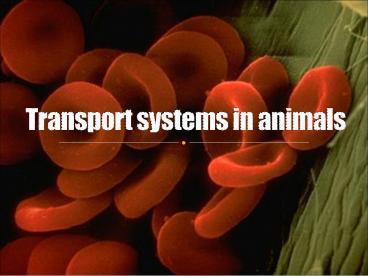Transport systems in animals - PowerPoint PPT Presentation
Title:
Transport systems in animals
Description:
Functions of a transport/circulatory system Invertebrate circulation Diffusion Aided by gastrovascular cavity Water vascular system Open circulatory system Closed ... – PowerPoint PPT presentation
Number of Views:377
Avg rating:3.0/5.0
Title: Transport systems in animals
1
Transport systems in animals
2
Well be discussing
- Functions of a transport/circulatory system
- Invertebrate circulation
- Diffusion
- Aided by gastrovascular cavity
- Water vascular system
- Open circulatory system
- Closed circulatory system
- Vertebrate circulation
- Fishes
- Amphibians
- Reptiles
- Birds
- Mammals
- Pathway of blood
- Cardiac cycle
- Maintenance of heartbeat
- Principles governing blood circulation
- Lymphatic system
- Blood composition and function
- Cardiovascular disease
3
Functions of the circulatory system
- Transports materials
- Nutrients from digested food
- Respiratory gases CO2 and O2
- Waste materials toxins and nitrogenous wastes
- Antibodies
- Hormones
- Enzymes
- Immune functions
- Maintains homeostasis
- Blood pH
- Heat transport
4
How are materials transported in multicellular
organisms?Phylum Porifera
5
How are materials transported in multicellular
organisms?
- Gastrovascular cavity in simple invertebrates
- Cnidarians (e.g. Hydra) and flatworms (e.g.
planarians) - No system required
- Single opening exchange of materials with the
environment - Central cavity for digestion and distribution of
substances throughout the body - Body walls two cell layers thick ? materials
undergo diffusion
6
How are materials transported in multicellular
organisms?
- Water vascular system in echinoderms
- multi-purpose locomotion, food and waste
transport, respiration - movement of muscles pump water into canals
- closed system of canals connecting tube feet
- madreporite ? ring canal ? radial and lateral
canal ? tube feet ? ampullae
7
How are materials transported in multicellular
organisms?
- Open circulatory system
- Phylum Arthropoda, Phylum Mollusca (with one
exception) - hemolymph
- heart(s) ? sinuses ? ostia ? heart(s)
- diffusion from sinuses to organs
- often serve a support purpose
- disadvantage loss of pressure in sinuses
- insects well-developed respiratory systems, O2
not transported through the blood
8
How are materials transported in multicellular
organisms?
- Closed circulatory system or cardiovascular
system - cephalopods, annelids, vertebrates
- presence of blood vessels
- advantages
- rapid flow
- may direct blood to specific tissues
- blood cells and large molecules remain within
vessels - can support higher levels of metabolic activity
9
General plan of the cardiovascular system
- Heart
- Atrium
- Ventricle
- Blood vessels
- Arteries
- Arterioles
- Capillaries and capillary beds
- Venules
- Veins
- Blood
10
Vertebrate adaptations of the cardiovascular
system
- FISHES
- Single-circulation
- Fish heart
- 2-chambered
- atrium and ventricle
- African lungfish heart
- 3-chambered
- 2 atria
- LA O2-rich blood
- RA O2-poor blood
- spiral fold
- partially divided ventricle
11
Vertebrate adaptations of the cardiovascular
system
- Amphibians
- Pulmocutaneous and systemic circulation are
partly separated - Amphibian heart
- 1 ventricle
- 2 atria
- LA O2-rich blood
- RA O2-poor blood
- advantage oxygen-rich blood reaches the bodys
organs faster - disadvantage some mixing of O2-rich and poor
blood occurs
12
Vertebrate adaptations of the cardiovascular
system
- Reptiles
- Reptilian heart
- 3-chambers (crocodilians have 4)
- 2 atria
- 1 ventricle (2 in crocodiles and alligators)
- partially divided, decreases mixing
13
Vertebrate adaptations of the cardiovascular
system
- Birds and Mammals
- 4 chambered heart
- 2 atria
- 2 ventricles
- full separation of pulmonary and systemic
circuits - Advantages
- no mixing of oxygenated and deoxygenated blood
- gas exchange is maximized
- pulmonary and systemic circuits operate at
different pressures - Importance
- Endothermic ? high nutrient and O2 demands in
tissues - Numerous vessels ? great deal of resistance, so
requires high pressure
14
Blood flow in mammals
- R side of heart
- pulmonary circuit
- L side of heart
- systemic circuit
- one way valves
- atrioventricular valves
- semilunar valves
15
Blood flow in mammals
- right atrium receives O2-poor blood from superior
and inferior venae cavae - from right atrium into the right ventricle
through the tricuspid valve - pumped into the pulmonary artery through the
pulmonary semilunar valve to lungs - O2-rich blood from lungs is returned to the left
atrium via the pulmonary veins - enters the left ventricle via the mitral or
bicuspid valve - exits the left ventricle into the aorta via the
aortic semilunar valve - circulated to body tissues































